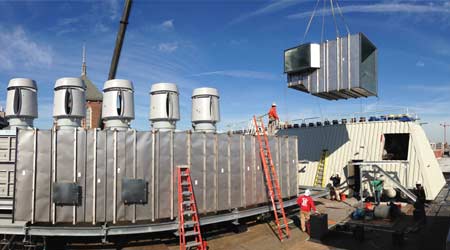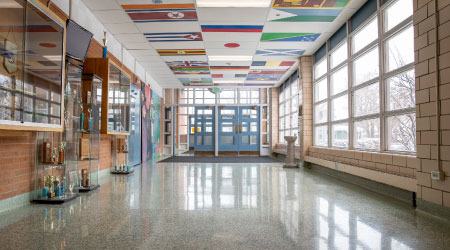Mastering Unique Challenges of College Renovations
First of a 3-part article offering tips on how to keep major education projects on time and on budget
A renovation on a large college campus presents unique challenges. For one thing, a range of groups play special roles, including administration, professors, students, subcontractors, architects, engineers, and the surrounding community. At the same time, college renovations involve such typical everyday construction responsibilities as understanding the preexisting structure, managing multiple funding sources, managing waste and material, determining storage space, and organizing shifts. Other major keys to success include managing occupant concerns, scheduling issues, the budget, and communication.
With all these challenges, the students’ education is of primary concern, so it is essential to plan strategically and communicate effectively to remain on schedule without interrupting ongoing academic activities. An environment of collaboration is critical.
The University of Pennsylvania recently completed a comprehensive mechanical and lighting system renovation of the 1973 wing of the Chemistry Laboratories, referred to as Chem ’73. This upgrade of the deteriorated heating, ventilation, and air conditioning systems was part of the larger $200 million Century Bond Projects, which ultimately aim to help Penn reach its sustainability goals by increasing energy efficiency in the buildings on campus. The goals were established under the university’s Climate Action Plan.
The project included replacement of T12 fluorescent lighting fixtures with new T8 fixtures, which reduced the number of lamps by 70 percent and cut the lamps’ wattage from 40 watts to 28 watts. The work also included converting the ventilation controls from a constant to a variable air volume system and installing more efficient air handler units and exhaust fans. The university’s monitoring shows that energy use in Chem ’73 was running at about 67 percent below the pre-renovation levels after two months of building operation.
The Chem ’73 project offers lessons in four areas crucial to the success of major renovations on college campuses.
Occupant Concerns
As with many campus renovations, Chem ’73 was an important building for many university functions such as labs, lecture halls, and office spaces. So it was necessary to complete this work while the building remained occupied, which increased the visibility and complexity of an already complex project.
For example, VAV work above the ceiling had to be conducted without disturbing campus activities and events. During this process, more than 500 valves and their associated infrastructure were installed above the ceiling throughout every floor of the building.
Knowing and understanding the occupants and functionality of each area of the building was critical to developing a logical phasing plan for this work. The goal is to start and finish each phase on schedule while maintaining a flexible approach, which helps projects stay on-track as they progress through the schedule.
A good example is the replacement of the fume hood exhaust fans. One air handling unit, containing six exhaust fans, generated the exhaust for more than 200 hoods in the building. Each existing exhaust hood had to be switched from the old fan to the new service, so giving proper notice to the researchers and students was key. In order to do this, a complex tie-in phasing plan was developed and coordinated with Penn’s Environmental Health & Radiation Safety department and Chemistry occupants to ensure that all hoods were cleared for construction and would not be in use. Prior to starting the next sequence of tie-ins, each hood had to be tested and cleared for use. This was an enormous effort and relied on constant and effective communication to ensure success.
Related Topics:














